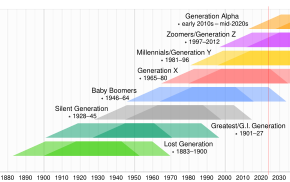Greatest Generation: Difference between revisions
removing a protection template from a non-protected page (info) |
Fixed typo Tags: Mobile edit Mobile web edit |
||
| Line 2: | Line 2: | ||
{{Generations Sidebar}} |
{{Generations Sidebar}} |
||
The '''G.I. Generation''' (also known as the ''' |
The '''G.I. Generation''' (also known as the '''World War II Generation''' or '''[[The Greatest Generation]]''' in the United States or the '''Federation Generation''' in [[Australia]]) is the demographic cohort following the [[Lost Generation]]. There are no precise dates for when this cohort starts or ends; demographers and researchers typically use the early 1900s as starting birth years and ending birth years in the mid-1920s. |
||
==Definition== |
==Definition== |
||
Revision as of 11:09, 6 March 2019
| Part of a series on |
| Social generations of the Western world |
|---|
 |
The G.I. Generation (also known as the World War II Generation or The Greatest Generation in the United States or the Federation Generation in Australia) is the demographic cohort following the Lost Generation. There are no precise dates for when this cohort starts or ends; demographers and researchers typically use the early 1900s as starting birth years and ending birth years in the mid-1920s.
Definition
This generation experienced much of their youth during rapid technological innovation (radio, telephone) amidst growing levels of worldwide income inequality[1][2][3] and a soaring economy.[4][5][6] After the Stock Market crashed, this generation experienced profound economic and social turmoil, and eventually World War II.
Demographers William Stauss and Neil Howe wrote about the "G.I. Generation" in their 1991 book Generations: The History of America's Future[7] and use 1901–1924 as birth years.[8] The initials "G.I." of "G.I. Generation" is military terminology referring to "Government Issue" or "General Issue". This cohort is also referred to as the "World War II Generation".[9]
McCrindle Research expanded on Howe's work and uses the term Federation Generation to describe Australian members of this cohort, born between 1901–1924, "a time of peace when Australia finally secured nationhood" who came of age during The Great Depression and WWII and experienced post-war prosperity in midlife.[10][11]
Pew Research Center defines this cohort as being born from 1901 to 1927.[12]
The term The Greatest Generation, which is a term sometimes used to refer to the US members of this cohort, comes from the title of 1998 book by American journalist Tom Brokaw. In the book, Brokaw profiled American members of this generation who came of age during the Great Depression and went on to fight in World War II, as well as those who contributed to the war effort on the home front. Brokaw wrote that these men and women fought not for fame or recognition, but because it was the "right thing to do."[13]
Notable members
Sample members include Walt Disney, Charles Lindberg, John Steinbeck, and Leonard Bernstein. Notable actors include Bob Hope, Katharine Hepburn, Sidney Poitier, Betty White, and John Wayne. U.S. presidents were Lyndon B. Johnson, Ronald Reagan, Richard Nixon, Gerald Ford, John F. Kennedy, Jimmy Carter and George H. W. Bush. The American automobile executive best known for making the development of Ford Mustang and Pinto cars Lee Iacocca and theoretical physicist and professor of physics Robert Oppenheimer.[14]
Prominent international peers include George Orwell, Leonid Brezhnev, Willy Brandt and Ferdinand Marcos.[15]
See also
References
- ^ "Striking it Richer" (PDF). eml.berkeley.edu.
- ^ "U.S. income inequality, on rise for decades, is now highest since 1928". 5 December 2013.
- ^ "5 facts about economic inequality". 7 January 2014.
- ^ Granados, José A. Tapia; Roux, Ana V. Diez (13 October 2009). "Life and death during the Great Depression". Proceedings of the National Academy of Sciences. 106 (41): 17290–17295. doi:10.1073/pnas.0904491106. PMID 19805076 – via www.pnas.org.
- ^ "Economy in The 1920s". www.shmoop.com.
- ^ George H. Soule, Prosperity Decade: From War to Depression: 1917–1929 (1947)
- ^ Strauss, William; Howe, Neil (1991). Generations: The History of America's Future, 1584 to 2069. Harper Perennial. ISBN 9780688119126.
- ^ Howe, Neil (30 July 2014). "The G.I. Generation and the "Triumph of the Squares"". Forbes. Retrieved 26 November 2016.
- ^ "The Greatest Generation". Investopia. Retrieved 26 November 2016.
- ^ Generations Defined. Mark McCrindle Archived 2016-06-16 at the Wayback Machine
- ^ McCrindle, Mark. "The ABC of XYZ Understanding the Global Generations" (PDF). McCrindle Research. Retrieved 25 May 2018.
- ^ "Americans Name the 10 Most Significant Historic Events of Their Lifetimes". People Press. 15 December 2016.
- ^ The greatest generation - Tom Brokaw - Google Boeken. Books.google.com. 1998. ISBN 9780375502026. Retrieved 2013-12-16.
- ^ Strauss, William; Howe, Neil (1991). Generations: The History of America's Future, 1584 to 2069. Harper Perennial. ISBN 978-0688119126. p. 262
- ^ Strauss, William; Howe, Neil (1991). Generations: The History of America's Future, 1584 to 2069. Harper Perennial. ISBN 978-0688119126. p. 262
